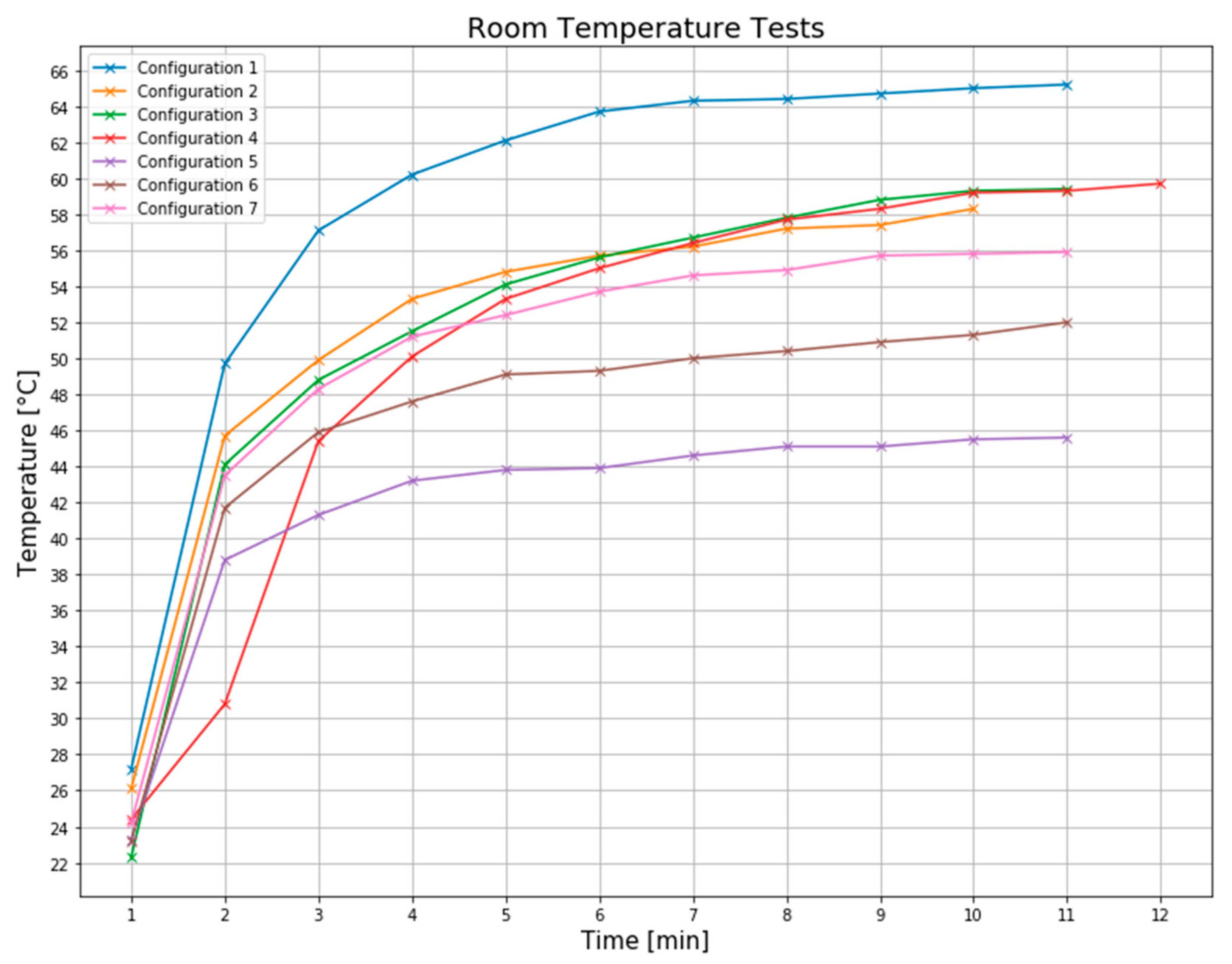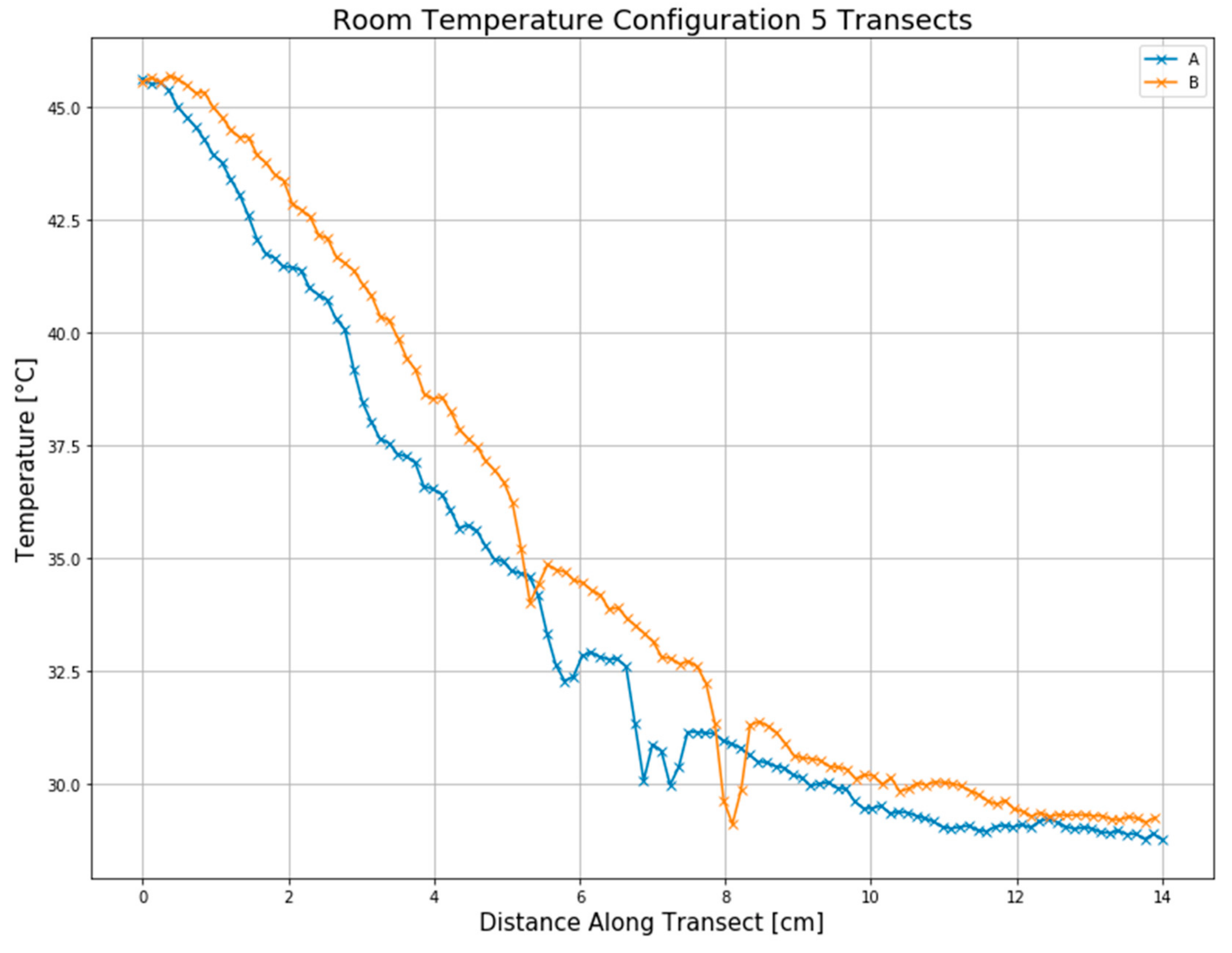Thermal Performance of Double-Sided Metal Core PCBs
Abstract
:1. Introduction and Overview of the Research and Results of System Performance That This Technical Note Supports
2. Materials and Methods
2.1. Materials
2.2. Location of LED and LED Drivers
2.3. Experimental Methods
- Set power supply to 18 V, [turned off].
- Connect power supply leads to the active LEDs for given test.
- Using electrically isolated tape, secure thermocouple temperature probe to the PCB board near one of the LEDs that will be on [to verify thermal image temperature reading emissivity settings on IR imaging camera are correct].
- Turn the power supply on then
- At 1-min intervals, capture a thermal image of the board using the FLIR camera, and record thermocouple temperature reading
- Repeat step a until the board temperature stabilizes
3. Results
3.1. Room Temperature Tests
3.2. Heated Tests
4. Summary
Author Contributions
Funding
Conflicts of Interest
References
- Martin, D. A practical guide to machine vision lighting. Retrieved 2007, 11, 2013. [Google Scholar]
- Narendran, N.; Gu, Y. Life of led-based white light sources. J. Disp. Technol. 2005, 1, 167. [Google Scholar] [CrossRef]
- Todorov, D.G.; Kapisazov, L.G. Led thermal management. Electronics 2008, 2008, 139–144. [Google Scholar]
- Lasance, C.J.M.; Poppe, A. Thermal Management for LED Applications; Springer-Verlag: New York, NY, USA, 2014. [Google Scholar]
- Yung, W.K.C. Using metal core printed circuit board (MCPCB) as a solution for thermal management. J. HKPCA 2007, 24, Q2. [Google Scholar]
- Van Driel, W.D.; Fan, X.J. Solid State Lighting Reliability: Components to Systems; Springer-Verlag, Science & Business Media: New York, NY, USA, 2012; Volume 1. [Google Scholar]
- Yung, K.C.; Liem, H.; Choy, H.S. Heat transfer analysis of a high-brightness LED array on PCB under different placement configurations. Int. Commun. Heat Mass Transf. 2014, 53, 79–86. [Google Scholar] [CrossRef]
- Ngo, I.L.; Jang, H.; Byon, C.; Lee, B.J. Experimental study on thermal performance of SMD-LED chips under the effects of electric wire pattern and LED arrangement. Int. J. Heat Mass Transf. 2018, 127, 746–757. [Google Scholar] [CrossRef]
- Zhou, J.; Huang, J.; Wang, Y.; Zhou, Z. Thermal distribution of multiple led module. Appl. Therm. Eng. 2016, 93, 122–130. [Google Scholar] [CrossRef]
- Jang, H.; Lee, J.H.; Byon, C.; Lee, J. Innovative analytic and experimental methods for thermal management of SMD-Type LED chips. Int. J. Heat Mass Transf. 2018, 124, 36–45. [Google Scholar] [CrossRef]
- Tang, Y.; Ding, X.; Yu, B.; Li, Z.; Liu, B. A high power led device with chips directly mounted on heat pipes. Appl. Therm. Eng. 2014, 66, 632–639. [Google Scholar] [CrossRef]
- Hsieh, J.-C.; Lin, D.T.W.; Cheng, C.-H.; Kingkaew, S.; Chen, S.-C. The optimal design of the thermal spreading on high power LEDs. Microelectron. J. 2014, 45, 904–909. [Google Scholar] [CrossRef]
- Sufian, S.F.; Fairuz, Z.M.; Zubair, M.; Abdullah, M.Z.; Mohamed, J.J. Thermal analysis of dual piezoelectric fans for cooling multi-led packages. Microelectron. Reliab. 2014, 54, 1534–1543. [Google Scholar] [CrossRef]
- Yung, K.C.; Liem, H.; Choy, H.S.; Lun, W.K. Thermal performance of high brightness led array package on PCB. Int. Commun. Heat Mass Transf. 2010, 37, 1266–1272. [Google Scholar] [CrossRef]
- Ong, Z.Y.; Subramani, S.; Devarajan, M. Thermal simulation analysis of high power led system using two-resistor compact LED model. In Proceedings of the Fifth Asia Symposium on Quality Electronic Design (ASQED 2013), Penang, Malaysia, 26–28 August 2013; pp. 334–338. [Google Scholar]
- Lee, C.Y.; Liu, J.L. Illumination based on high-power white light-emitting diode array. Int. J. Green Energy 2012, 9, 421–429. [Google Scholar] [CrossRef]
- Park, S.-J.; Jang, D.; Yook, S.-J.; Lee, K.-S. Optimization of a chimney design for cooling efficiency of a radial heat sink in a LED downlight. Energy Convers. Manag. 2016, 114, 180–187. [Google Scholar] [CrossRef]
- Shen, Q.; Sun, D.; Xu, Y.; Jin, T.; Zhao, X. Orientation effects on natural convection heat dissipation of rectangular fin heat sinks mounted on LEDs. Int. J. Heat Mass Transf. 2014, 75, 462–469. [Google Scholar] [CrossRef]










| Name | Quantity | Manufacturer | Model |
|---|---|---|---|
| Thru-Hole LED Drivers | 3 | Mean Well USA Inc. | 709-LDD-700L |
| Surface mount LEDs | 18 | Lumileds | L1V2-6570000000000 |
| Solder Paste | 1 | Chip Quik | FBA_5880 |
| PCB Stencil | 1 | PCBWay | |
| MCPCB | 1 | PCBWay | |
| Thermal Imaging Camera | 1 | FLIR | i7 |
| Thermometer | 1 | OMEGA | HH506RA |
| Low Noise Power Supply (set to 18V) | 1 | Potrans | FS-32024-1M |
| 26 Qt Cooler | 1 | Igloo | 00040358 |
| Name | Description |
|---|---|
| Light_Board_Small_V2.sch | EAGLE schematic file |
| Light_Board_Small_V2.brd | EAGLE board file |
| Configuration Number | Description |
|---|---|
| 1 *,† | Top Left, top right, and bottom left LED groups on |
| 2 * | Top left and top right LED groups on, bottom left LED group off |
| 3 * | Top left and bottom left LED groups on, top right LED group off |
| 4 * | Top right and bottom left LED groups on, top left LED group off |
| 5 * | Top left LED group on, top right and bottom left LED groups off |
| 6 * | Top right LED group on, top left and bottom left LED groups off |
| 7 * | Bottom left LED group on, top left and top right LED groups off |
© 2019 by the authors. Licensee MDPI, Basel, Switzerland. This article is an open access article distributed under the terms and conditions of the Creative Commons Attribution (CC BY) license (http://creativecommons.org/licenses/by/4.0/).
Share and Cite
Pelletier, M.G.; Preston, S.C.; Cook, J.A.; Tran, K.D.; Wanjura, J.D.; Holt, G.A. Thermal Performance of Double-Sided Metal Core PCBs. AgriEngineering 2019, 1, 539-549. https://doi.org/10.3390/agriengineering1040039
Pelletier MG, Preston SC, Cook JA, Tran KD, Wanjura JD, Holt GA. Thermal Performance of Double-Sided Metal Core PCBs. AgriEngineering. 2019; 1(4):539-549. https://doi.org/10.3390/agriengineering1040039
Chicago/Turabian StylePelletier, Mathew G., Stone C. Preston, Jim A. Cook, Kevin D. Tran, John D. Wanjura, and Greg A. Holt. 2019. "Thermal Performance of Double-Sided Metal Core PCBs" AgriEngineering 1, no. 4: 539-549. https://doi.org/10.3390/agriengineering1040039
APA StylePelletier, M. G., Preston, S. C., Cook, J. A., Tran, K. D., Wanjura, J. D., & Holt, G. A. (2019). Thermal Performance of Double-Sided Metal Core PCBs. AgriEngineering, 1(4), 539-549. https://doi.org/10.3390/agriengineering1040039






